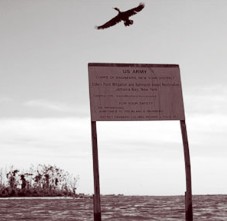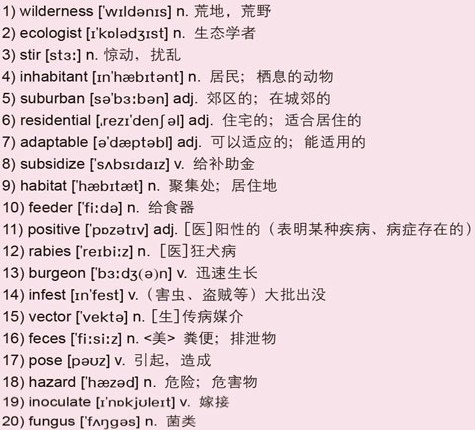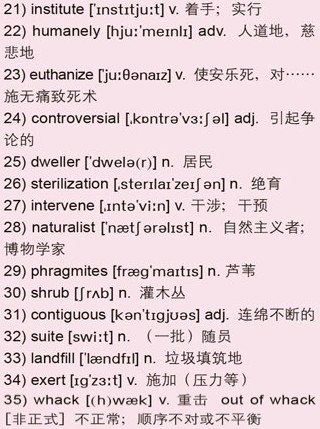随着人类保护动物的意识日益加强,越来越多的野生动物不都只在荒郊野外繁衍生息了,它们进驻到都市,和人类共同生活。许多动物在城市里自由穿梭,见到人类一点儿也不“害羞”。纽约就是这样一个你会随处见到野生动物的城市,如果只是可爱的小松鼠蹦跳着走过街道,市民当然是一点儿意见都没有,但要是经常见到豺狼出没,那可就不见得了。本期《无限播客》栏目,就为你带来野生动物在大都市的生活。感受一下那些身临其境的人们对它们又爱又恨的纠结情感,我们似乎又有了一个难题要考虑——如何解决城市里动物与人日益加剧的矛盾?
由于本文涉及到大量生物类的词汇,有一定难度,而这些名词可能大家平时少有用到,所以小编就在文中用其他颜色标识,在文后的小链接中作了简单介绍,不再加注,供大家参考了解,也方便大家归类学习。
发音:英美发音
语速:163词/分钟
使用方法:泛听+讨论
John Stewart: I'm John Stewart.
Not all wildlife is restricted to the 1)wilderness, and not all of it is welcome. Living alongside millions of people in New York City you can now find increasing numbers of raccoons, geese, skunks and deer. Some 2)ecologists are warning that their growing numbers will lead to increasing conflict between New Yorkers—human and animal. Reporter Laura Sheeter went out to explore.
约翰·斯图尔特:我是约翰·斯图尔特。
野生动植物不一定都只在荒郊野外繁衍生息,也不一定都能赢得人们的欢心。作为数百万纽约居民的一员,你会发现如今身边出现了越来越多的浣熊、大雁、臭鼬和野鹿。一些生态学家已经发出警告说,这会导致“纽约客”(人和动物)之间的矛盾激增。下面由记者罗拉·施特带来外景采访。
Laura Sheeter: When wildlife comes to New York, it creates a 3)stir. In recent months, more than one coyote sighting has made the news. Ecologists now believe these are more than just visits and that coyotes could be here to stay.
These American jackals may be one of the most unusual of the city's wild 4)inhabitants, but Professor Paul Curtis from Cornell University says there are growing populations of many other species in and around New York.
Paul Curtis: Coyotes, deer, Canada geese, raccoon...many of these species have their highest densities in more 5)suburban 6)residential neighbourhoods, even higher densities than you'd see in natural woodlands. There are many species that are very 7)adaptable and do well in what we call 8)subsidized 9)habitat, where there's a man-made food source—things like bird 10)feeders, gardens…
 罗拉·施特:纽约这个大城市出现野生动物,难免引起轰动。最近几个月,就不止一次有人在纽约发现土狼踪影,新闻也大肆报道。生态学家们现在都认为这些土狼不是进城来玩玩而已,它们有可能是来长住的。
罗拉·施特:纽约这个大城市出现野生动物,难免引起轰动。最近几个月,就不止一次有人在纽约发现土狼踪影,新闻也大肆报道。生态学家们现在都认为这些土狼不是进城来玩玩而已,它们有可能是来长住的。
这些美洲豺狼恐怕也是驻足纽约的野生动物中最为稀奇的一种,而美国康奈尔大学的教授保罗·科提斯表示,在纽约城内外其他不同种类的野生动植物也越来越多。
保罗·科提斯:土狼、野鹿、加拿大黑雁、浣熊……这些动物很多在市郊住宅区内分布最为密集,比你在天然林地里看到的还多。不少野生动物有着强大的适应性,能在所谓“优厚栖居地”过得如鱼得水,这些地方通常都有人为食物来源,比如装有鸟饲料喂食器,或是设有雀鸟花园,等等。
Laura: Well, Central Park is Manhattan's green heart, and it has plenty of wildlife. In fact, there are signs up here warning people to stay away from wild animals because raccoons in the park have recently tested 11)positive for 12)rabies. So what do New Yorkers make of the 13)burgeoning wildlife in their city?
Woman 1: I wouldn't mind seeing geese or a raccoon, but I don't know about a deer (laugh) in the city; it's just a little too much.
Woman 2: Well, just 'cause we don't like them doesn't mean they don't have a right. (laughing)
Laura: And what do you make of the raccoons? I've seen the signs up here warning people that they might have rabies.
Woman 2: They can be...they can, yes, but they're rather charming. I like their eyes. They look like they're wearing eye make-up. (laughing) I think it's nice to have animals, as long as it's not 14)infesting my apartment, of course. (laughing)
罗拉:纽约中央公园可谓是曼哈顿的绿色心脏,拥有大量野生动植物。其实,这里有竖着告示牌警告游人不要靠近野生动物,因为园内最近有浣熊被验出带有狂犬病毒。那么,究竟纽约居民对于城里日增的野生动物是怎么看的呢?
受访女士一:我不介意看到大雁或者浣熊,但是野鹿(笑)在城市里出现,这就有点太过了吧。
受访女士二: 嗯……就算我们不喜欢这种动物,也不能抹杀它们的选择权呀。(笑)
罗拉:那你觉得浣熊怎么样?我看到这里有让人们小心感染到狂犬病的警告牌。
受访女士二:是有可能受感染的,不过它们也很可爱呀。我喜欢浣熊的眼睛,像化了妆一样。(笑)我觉得有动物在挺好的,当然,只要别来大军进占我家。(笑)
Laura: Though they may be entertaining or cute, city animals are increasingly coming into conflict with people, as professor Curtis explains.
Paul: The issue with raccoons is they're the primary rabies 15)vector species in New York and other eastern states, so it's a really a [sic] potentially a [sic] health and safety issue for both people and pets.
Laura: As for geese, their 16)feces makes an unwelcome mess on golf courses and playgrounds, but they 17)pose an even more serious risk. In January last year, a US Airways flight leaving New York hit a flock of Canada geese and both its engines failed. Only the skill of the pilot, landing on the Hudson River, saved the lives of those on board. For New York's airports, geese pose a real danger. Laura Franker is their chief wildlife biologist. It's her job to find a way to keep birds and planes apart.
Laura Franker: We realize that you can't just manage wildlife 18)hazards on the airport. You have to go off the airport to be effective. On the airports we've been using a type of grass that's 19)inoculated with a 20)fungus, so when the geese eat it, it gives them a little bit of a stomachache. Last year we 21)instituted a city-wide Canada goose round-up, so we round up the geese then and remove them from these properties. And they're actually 22)humanely 23)euthanized after that.
罗拉:这些动物或许滑稽有趣,也有可爱之处,但在城市里,动物与人的矛盾却日益加剧,且听科提斯教授为我们解释。
保罗:浣熊的问题是,在纽约和美国其他东部城市里,它们是狂犬病毒的最主要传播载体,所以,对人和宠物来讲,都是个潜在的健康安全隐患。
罗拉:而大雁的问题就是,它们的粪便会撒落在高尔夫球场和操场空地上,让人讨厌。另外大雁还会造成更严重的危险。去年一月,美国航空公司从纽约出发的一架飞机在空中撞到了一群加拿大黑雁,导致两个引擎失灵。全凭机师的经验技巧,飞机最终成功急降哈德逊河上,挽回了机上乘客和机组人员的性命。对于纽约的大大小小机场而言,大雁的确是很危险的。罗拉·弗兰克是这些机场的首席自然生物学家。她的职责就是要想办法不让飞鸟和飞机撞到一起。
罗拉·弗兰克:我们明白,不能只知道在机场范围内防范野生动物带来的危险,还得在机场以外有效抗扰。我们在机场里种有嫁接了一种菌类的草,雁鸟吃了就会有点肚子疼。去年,我们在全城发动了一场加拿大黑雁“围剿”行动。我们从这些地点把它们围捕然后清走。在那之后,它们最终都被人道地“安乐死”处置了。
Laura: But killing wild birds and animals can be 24)controversial, especially among city-25)dwellers unused to hunting. Alternative options like 26)sterilization are expensive, but there are other reasons to 27)intervene as successful urban creatures don't just pose a threat to people. They compete with rarer wildlife in the city's parks and green areas.
Before dawn in southern Brooklyn, and Mike Feller, the chief 28)naturalist for New York City's parks, is off to a small island to count breeding birds.
Mike Feller: The expectation is, later in the year, by next year, killing the 29)phragmites, removing the last trees and 30)shrubs, and then covering with sand and getting what…what'll basically be about 90 acres of 31)contiguous grassland.
Laura: So what are you hoping will come in?
Mike: There's a 32)suite of grassland nesting birds—grasshopper sparrow, savanna sparrow, upland sandpiper, eastern meadowlark. Those are the birds that the habitat is targeted for. It will also benefit birds like the northern harrier, the marsh hawk, possibly short-eared owls.
Laura: On a former 33)landfill site, Mike and his team are trying to create a specialist habitat, kicking out the most common species so rarer sand and grassland dwellers can find a home.
Mike: It's wonderful that people have more of an opportunity to see cute, cuddly wildlife in their parks, but I have the concern that there's at least the possibility that there can be too many raccoons. The number of raccoons then 34)exert [sic] a greater pressure on other small animals, bird nesting…So I guess the bigger issue for me is this idea of the sustainability of populations because of the mess that we've made of things. If anything becomes too abundant, it throws the whole system out of 35)whack.
罗拉:但捕杀野鸟野生动物又是备受争议的,尤其是我们这些看不惯狩猎的城市人。可是,不这样,其他方法,如绝育手段又相当昂贵。我们之所以要插手干预这态势,不单纯是因为安居城市的野生动物会对人造成威胁,其实还有别的原因:在城市的公园和绿化带内,它们会与一些更珍稀的野生动物竞争生态资源。
南布鲁克林的清晨,纽约市公园的首席自然学家迈克·菲勒正出发到一个小岛上统计在岛上繁殖的野鸟数目。
迈克·菲勒:我们的设想是,今年年末到明年初,把这里的芦苇都拔掉,把剩下的树木和灌木丛都清走,然后铺上沙,形成基本上有90英亩大的整片草地。
罗拉:那你希望这样能吸引些什么野鸟进来呢?
迈克:会有一系列喜欢在草地筑巢的野鸟飞来,包括黄胸草鹀、稀树草鹀、高原鹞、东方野云雀。那些野鸟就是我们这片绿地的目标所在,另外,北方猎鹰、灰鹰,甚至短耳猫头鹰也能受惠。
罗拉:在一片之前填海所得的地块上,迈克和他带领的团队正努力建造一片野鸟专属栖息地,铲除了最普通的物种,方便喜居沙草地的珍稀野鸟落户栖身。
迈克:大家能有更多的机会在公园里看到可爱逗趣的野生动物,这很好,但我会担心,浣熊也未免太多了,会给其他小动物带来更大的生存压力,也会影响到鸟雀筑巢孵蛋……所以我觉得,我更关心的是物种数量的可持续性发展,要知道现在的世界已经给我们弄得一团糟了,如果某些物种数量太多了,是会让整个生态系统失衡的。
小链接——文中提及的野生动物
raccoon 浣熊
原产自北美洲,因其进食前要将食物在水中浣洗,故名浣熊。
Canada goose 加拿大黑雁
又名黑额黑雁,产于北美洲。因种群数量较大,未被列入保护动物目录。
skunk 臭鼬
长着一身醒目的黑白相间的毛皮。遇到危险时可以放出奇臭的气味,故名为臭鼬。
coyote 郊狼
学名为Canis latrans,是美洲分布最广泛的一种犬科动物,适应能力极强,森林、沼泽、草原,甚至牧场和种植园都能看到它们的身影。
savannah sparrow 稀树草鹀
分布在北美地区和中美洲。


